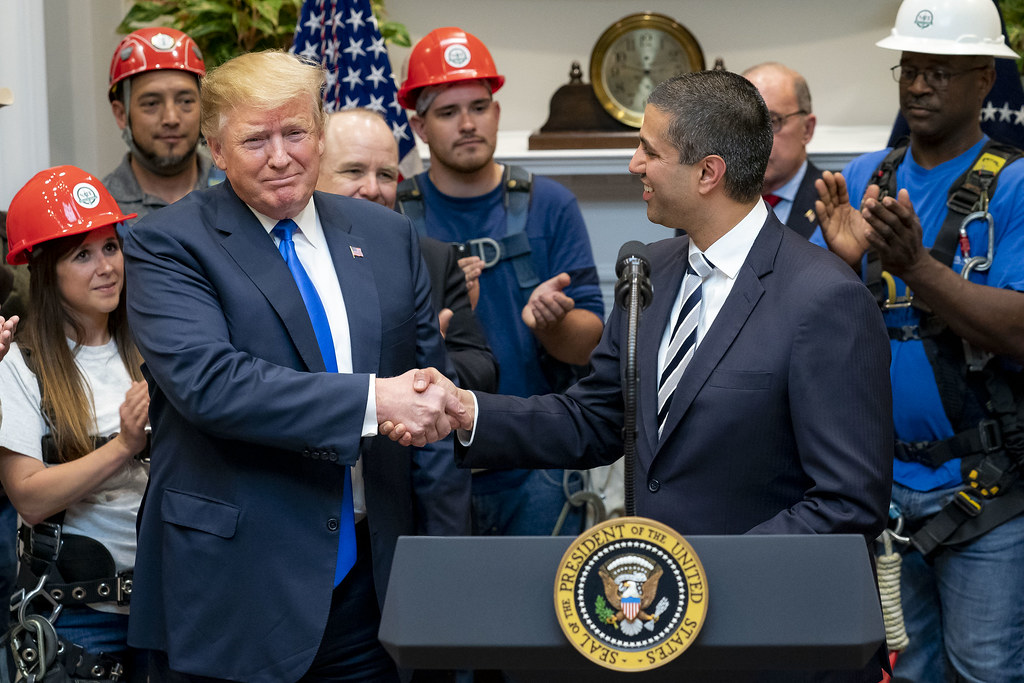Setting the Stage for U.S. Leadership in 6G
Every day there are more headlines about China’s rise in 5G, the next generation of wireless communications technologies, and the economic and national security risks to the United States that go along with these developing technologies.

Published by The Lawfare Institute
in Cooperation With

Every day there are more headlines about China’s rise in 5G, the next generation of wireless communications technologies, and the economic and national security risks to the United States that go along with these developing technologies. These concerns, particularly the threat of critical infrastructure disruptions, are valid—but the plight of the United States is in part self-inflicted. The U.S. government waited too long to tackle the difficult issues surrounding 5G. As a result, China has unprecedented clout on the global stage regarding the deployment and diffusion of advanced communications technologies.
The United States must learn from this experience and act to remain at the forefront in this critical area to help protect U.S. economic vitality and national security. Though it may sound premature, now is the time to focus on what comes next: 6G.
Even though 5G deployments are in their infancy and at risk of becoming trite as a policy concern, the long time horizons for technology development in this field mean that U.S. political and industry leaders cannot afford to wait when it comes to 6G. These advances will bring opportunities for breakthroughs in data transmission over shorter wavelengths than 5G—meaning much greater bandwidth at higher speeds—which are likely needed to achieve a true revolution in mobile networks. It will also create openings to upend the current hardware-focused market by promoting a software-focused one, with expected benefits in security, cost, supply-chain diversity and more competitive markets.
5G will likely bring advances across a spectrum of industries. More than just improved mobile telephony, 5G is poised to enable greatly improved military communication and situational awareness, autonomous vehicles, virtual reality, telemedicine and expansive device connectivity for a true “internet of things”—all possible due to the higher speed and capacity, and lower latency, of 5G networks. There are also likely to be unforeseen innovations and use cases.
U.S. policymakers and business leaders have the opportunity to build the foundation for American preeminence in 6G technologies this year and next. Many of the challenges the United States is grappling with concerning 5G would have been avoidable with more prudent planning a decade ago. With decisive action today, the U.S. can ensure its status as the undisputed leader in wireless technology within 10 years. In doing so, it will lock in the ability to build secure 6G infrastructure with all the accompanying economic and national security benefits.
The 5G Rollout Experience Holds Important Lessons
Years of research and development (R&D), policy formulations and standards-setting suggest several broad conclusions about the U.S. position in a world transitioning to 5G.
Trusted vendor diversity is needed to build secure 5G networks. The main obstacle the United States faces in encouraging its allies and partners to exclude the Chinese telecommunications firm Huawei from their national telecommunications infrastructure is the limited alternatives. No single firm offers the full range of kit required for a 5G network buildout, and none—due to Beijing’s lavish subsidies—can outdo Huawei on price. As a result, for many countries there is no practical 5G alternative to Huawei. They will instead look to costly and difficult mitigation strategies to manage the risks associated with operating Huawei 5G technology.
The U.S. faces mounting challenges to its leadership in wireless communications technology. An April 2018 study commissioned by CTIA, the organization that represents the U.S. wireless communications industry, concluded that China held a narrow lead over the U.S. in the race to 5G. A German intellectual property analytics firm assessed in December 2018 that Huawei made the most technical contributions to the 5G standard, followed by Ericsson (Sweden), HiSilicon (China) and Nokia (Finland). Qualcomm, the top U.S. company, was a distant fifth.
Growing Chinese clout in international standards-setting poses economic security risks to the U.S. Setting international standards for telecommunications has major financial implications; for 5G, the International Telecommunication Union (ITU) and the 3rd Generation Partnership Project are playing this role. Companies with the strongest influence over standards help to ensure that their products are competitive in the marketplace. More importantly, companies can position their relevant patents such that the standards body declares them 5G standard essential patents (SEPs)—patents that any company must use to implement a standardized 5G technology. This generates considerable licensing income to recoup R&D investments.
Finnish telecoms giant Nokia, for example, expects licensing income for mobile phones using its patents for the 5G New Radio standard to be up to 3 euros per device, and Qualcomm may charge as much as $16.25 per 5G phone. While its potential revenue is high, Qualcomm lags on SEPs. Although it is the highest-ranked U.S. company among top 5G SEP owners, it trails Samsung, Huawei, ZTE and Ericsson. Patent citation rates suggest, however, that Qualcomm’s patents are of higher overall quality.
Notably, the Committee on Foreign Investment in the United States cited the implications of increased Chinese influence over international standards as one of the reasons for blocking the acquisition of Qualcomm by Broadcom, a semiconductor manufacturer that, for a time, was headquartered in Singapore.
Belated and insufficient attention to 5G security standards poses undue risk. The conclusions of a July 2018 ITU 5G working group meeting show that, by that point, decisions were still yet to be made on fundamental security solutions regarding access control, authentication, public key infrastructure and virtual networking architecture that is essential to connectivity between devices. A year prior, American researchers proposed a new 5G security architecture based on a comprehensive study of feasible attacks on 5G networks and pervasive security flaws in 5G technologies. Similarly, a security analysis in 2018 of 5G technology by a group of European researchers found critical security gaps, such as a lack of mutual authentication requirements, that leave devices and networks vulnerable to cyberattacks.
This outcome was avoidable. The Federal Communications Commission (FCC) under Trump canceled two 5G cybersecurity initiatives begun during the Obama administration, which anticipated these very issues. One initiative focused on ensuring that the international 5G standard would have built-in cyber protections. The other was to work with industry and academia to determine how best to design cybersecurity into 5G from the outset.
The U.S. lags behind other countries in 5G infrastructure investments. A 2018 report by Deloitte found that China has outspent the U.S. by $24 billion in wireless communications infrastructure since 2015, resulting in a wireless site density—required to handle the increased speed and capacity of 5G—three times greater than the U.S. on a per-capita basis. Similarly, Germany has nearly double and Japan more than four times the site density of the United States.
Looking Ahead to 6G
6G has the potential for transmission speeds 10 times greater than 5G, near-zero latency and connection density as high as 10 million devices per square kilometer. This exceeds anything possible with 5G as planned. Such 6G capabilities probably will be needed to support high data transfer rates in cities, to ensure the safety of autonomous vehicles and to build next-generation secure communications. Indeed, some researchers are already expecting that 5G will fail to meet expectations due to bandwidth limitations, making 6G breakthroughs all the more desirable.
This is not an academic debate. Even though commercial rollout of 5G technologies is just beginning, planning for and investing in 6G wireless technologies is already underway. Estimates from experts in the United States, China and Europe envision initial rollout of 6G technologies around 2030.
Researchers are eyeing breakthroughs in areas like material research, chip design and power consumption. Another area of research holding great promise for 6G is technologies making communications in the high gigahertz (GHz) and terahertz (THz) range possible. Researchers believe that communications in frequencies above 95 GHz hold the key to numerous advantages, including strong penetrability (e.g., walls and clothing) and very high bandwidth. As such, this research is a primary area of focus at organizations like U.S.-based research center ComSenTer and Finland’s 6Genesis.
According to an interview with Su Xin, head of the Chinese Ministry of Industry and Information Technology’s 5G wireless technology working group, the ministry formally launched a concept study of potential 6G technologies in 2018, with R&D planned to start in 2020. Su anticipates 6G would outperform 5G on bandwidth, latency and connection; achieve transmission rates at least 10 times faster; and potentially revolutionize “the entire wired and wireless network.”
Likewise, in late 2017 the Japanese Ministry of Internal Affairs and Communications commissioned a working group to evaluate next-generation wireless technologies. The working group’s findings included that 6G transmission rates should be at least 10 times faster than 5G and that 6G would offer nearly instantaneous connection and a connection density of 10 million devices per square kilometer. Research into high-speed transmission has been underway for several years. Japanese researchers claimed to achieve 100 Gbps transmission speeds (100 times faster than existing networks) over short wavelengths in 2016, although they did not divulge over what distance this transmission occurred.
Finland, a perennial leader in wireless communications technology, boasts one of the more ambitious next-generation wireless communications technology efforts. The Academy of Finland, a governmental body that funds scientific research, set up the 6Genesis flagship program to develop new wireless technologies and 6G standards. Based at the University of Oulu, the goal of the eight-year program is to ensure that Finland is a 6G leader. Specific research areas include “near-instant unlimited wireless connectivity, distributed computing and intelligence, as well as materials and antennas at very high frequencies,” according to the program’s director. The University of Oulu hosted the 1st 6G Wireless Summit in late March 2019, featuring speakers from leading telecommunications firms and researchers from around the world.
Opportunities to Promote U.S. Leadership in 6G
Maintaining U.S. prominence in wireless communications technologies will require foresight and planning guided by a strategic vision articulated at the national level. While U.S. firms produce the foundational technology that makes 5G possible, companies such as Huawei seek to displace them. The overarching goal of the strategy should be to ensure that the United States has the most capable, reliable, secure—and, thus, desirable—6G technologies before 2030. To do so, policymakers and industry leaders should consider four key areas.
First are efforts to help the United States retain prominence in technology development and standards-setting, where China is increasingly competitive. The Trump administration and Congress should expand public funding for research and development of emerging technologies. One way would be to create a 6G Public Private Partnership, which could streamline efforts to develop technologies, architectures and standards through joint R&D and expert working groups. The European Union is starting to implement such a partnership based on its 5G effort, bringing together manufacturers, operators, service providers and researchers. Another option would be to promote international collaboration with like-minded wireless technology leaders such as Finland, Sweden, South Korea and Japan to encourage supply-chain diversity. Finally, expanded National Science Foundation grants and tax credits for qualified research and patent protection would spur R&D.
The second area involves promoting more open, more interoperable communications technologies. Huawei poses a challenge to U.S. and western technology companies in large part because it offers inexpensive soup-to-nuts hardware solutions that don’t work well with other vendors’ equipment, making it costly for customers to switch providers. To mitigate this, U.S. policymakers should signal support for efforts like the O-RAN Alliance, an international group of telecom operators and technology companies that seek to build networks based on virtualized network elements, white-box hardware and standardized interfaces. This approach promotes vendor diversity and customer choice, and it plays to U.S. strengths in software development. Congress should hold hearings to explore strategies for, and funding of, network virtualization (that is, the ability of software to simulate hardware to achieve greater efficiency and scalability), consider tax incentives for deploying such technology, and encourage the U.S. Department of Defense and intelligence community to be early adopters in order to indicate U.S. government support for this approach and encourage new entrants to the market.
Third is security. The United States must be the leader in developing secure hardware and software to provide the global market with a reliable alternative to less-trusted manufacturers such as China’s Huawei. Again, network virtualization offers an important avenue to consider: Vendor products must be interoperable, and marketplace competition incentivizes superior security practices. Participation by a range of federal government departments and agencies will be essential given that developments in 5G and other technology will be applied to connected cars, medical devices and smart grids.
Fourth is preparing for deployment and infrastructure. The Trump administration and Congress can take steps now to ensure an effective transition from 5G to 6G and reap the economic benefits of these advanced networks. Global research efforts suggest 6G spectrum resources are likely to be in the THz range. A long-term regulatory framework and road map ensuring that spectrum is available and affordable will help to stimulate investment. Encouragingly, the FCC opened up the THz wave spectrum (95 GHz to 3 THz) for experimental purposes in March 2019. Policymakers should update and standardize regulations and wayleave agreements; provide tax breaks for infrastructure investments; promote infrastructure sharing; and allow for licensed, shared-access spectrum to reduce costs.
There is much hand-wringing today among U.S. lawmakers and national security experts over the risks of having China—a geopolitical rival and a U.S. adversary—exert such influence over 5G technology. 5G will be the backbone of the global internet economy, touching all aspects of life. There is still time to right the ship on 5G and address much of the national security risks posed by Chinese strength, but U.S. political and business leaders must be proactive and prepare to harness the even bigger advances promised by 6G. The wheels are already in motion. The United States cannot afford to be lamenting its plight again 10 years hence. Sensible, far-sighted action today will avoid that fate.





